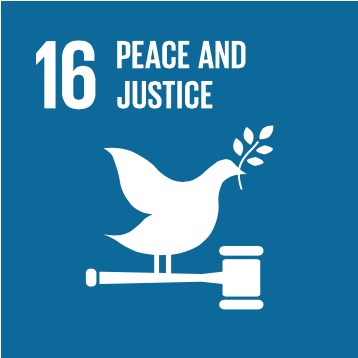
Donna Perry, Christian Guillermet Fernández, David Fernández Puyana
The inclusion of peace as a Sustainable Development Goal (SDG) is an important milestone and achievement. Transforming our World: The 2030 Agenda for Sustainable Development (Agenda) is a plan of action for people, planet and prosperity.1 It also seeks to strengthen universal peace within a larger freedom. SDG 16 calls for humanity to “Promote peaceful and inclusive societies for sustainable development, provide access to justice for all and build effective, accountable and inclusive institutions at all levels.”2 The establishment of this goal makes clear that peace is a critical condition for human development. The goal and its targets address important conditions for peace such as inclusion, participatory decision-making and protection of children.
The potential for this goal to advance peace can more fully be appreciated within the context of the Agenda. The text articulates that the goals are interrelated and indivisible. The goals and targets will stimulate action over the next 15 years in areas of critical importance for humanity and the planet. Aims such as ending poverty, reducing inequality, ensuring health and protecting ecosystems are interrelated with the advancement of peace. In accordance with the Agenda, “sustainable development cannot be realized without peace and security; and peace and security will be at risk without sustainable development”.3
Importantly, SDG 4 on education calls to ensure that by the target date of 2030 “all learners acquire the knowledge and skills needed to promote sustainable development, including, among others, through education for sustainable development and sustainable lifestyles, human rights, gender equality, promotion of a culture of peace and non-violence, global citizenship and appreciation of cultural diversity…”4 The acknowledgement of the need for a culture of peace is significant. Achieving a sustainable peace will require a profound transformation in human consciousness. The placement of this target as integrated within the SDG for education reinforces the interrelated nature of the goals. It also highlights the importance of education for cultural transformation. Indeed, this is aptly captured in the title of the Agenda, “Transforming Our World”.
There are some limitations to be noted in the specific targets within SDG 16. For example, while the text calls for significant reduction in “all forms of violence” several of the targets seem focused on those dimensions of violence that flow from criminal activity. The emphasis on reduction of “illicit financial and arms flows” while important, omits mention of States’ obligations in this regard. It is important to recall the Charter of the United Nations in which Member States affirm their responsibility to settle disputes by peaceful means. Even legally sanctioned weapons can cause grievous harm and injury.
While a full elaboration of the conditions for peace is not provided in the text, the Agenda provides an important foundation from which to move toward peaceful and sustainable development for humankind. The next challenge will be for all nations, institutions and members of the global community to work together to make the necessary changes for the meaningful realization of peace and all SDGs.
As the global community moves towards implementation of this Agenda it is important to note the linkage of the SDGs with the realization of “human rights for all”. Linking to a human rights framework makes clear that these goals are not merely lofty aspirations but markers of obligation for the global community. It follows that peace and security, development and human rights are the pillars of the UN system.
Indeed, the establishment of peace as an SDG dovetails with a contemporary global initiative within the UN Human Rights Council for the adoption of a declaration on the right to peace. This declaration will create the basis to further elaborate the necessary conditions aimed at creating a more peaceful world. An article addressing this topic and the role of health professionals in building peace was recently published in the Health and Human Rights Journal.5
At a time when millions of refugees are fleeing violence across the globe, realizing peace is an urgent need. And just as the goal of a sustainable peace is interrelated with other development goals, the actions of building peace must be integrated within the work of multiple sectors. Health professionals must act together with members of other disciplines to accept our mutual responsibility and to transform the world for peace.
In the call for action to change our world, the Agenda stressed that “seventy years ago, an earlier generation of world leaders came together to create the UN. From the ashes of war and division they fashioned this Organization and the values of peace, dialogue and international cooperation which underpin it.”6 It follows that, as also indicated, “the future of humanity and of our planet lies in our hands.”7
Donna J. Perry, PhD, RN, is Assistant Professor at the University of Massachusetts, Worcester Graduate School of Nursing and Vice Chair of the Board of the Center for Nonviolent Solutions in Worcester, MA, USA.
Christian Guillermet Fernández, BA, Chairperson-Rapporteur of the Open Ended Working Group on the Right to Peace and Vice- Director General for Foreign Policy at the Ministry of Foreign Affairs of Costa Rica
David Fernández Puyana, BA, LLM, PhD (European Mention), legal assistant of the Chairperson-Rapporteur and assistant on the right to peace of the OHCHR for the preparation and 30th session of the Human Rights Council
1 Transforming Our World: the 2030 Agenda for Sustainable Development -Finalised Text for Adoption (1August), available at: https://sustainabledevelopment.un.org/content/documents/7891Transforming%20Our%20World.pdf
2 ibid, p. 12
3 ibid, para 34
4 ibid, p. 15
5 D Perry, C Guillermet Fernánde, D F Puyana, “The Right to Life in Peace: An Essential Condition for Realizing the Right to Health”, Health and Human Rights Journal, 17/1, 2015, pp. 1148-158, available at https://www.hsph.harvard.edu/hhrjournal/wp-content/uploads/sites/2469/2015/06/Perry.pdf)
6 see note 1, para 49
7 ibid, para 53
Recent publications by the authors in the Health and Human Rights Journal:
The Right to Life in Peace: An Essential Condition for Realizing the Right to Health
